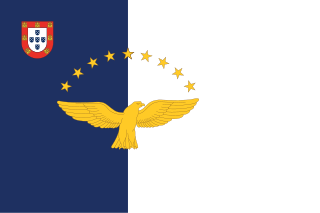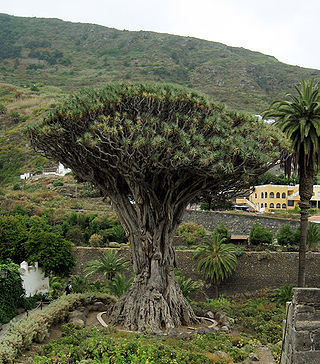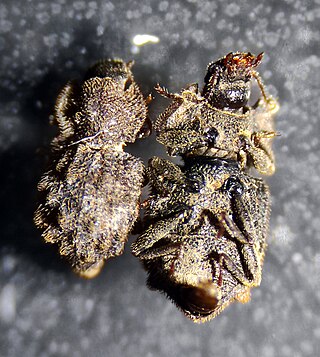
The Azores, officially the Autonomous Region of the Azores, is one of the two autonomous regions of Portugal. It is an archipelago composed of nine volcanic islands in the Macaronesia region of the North Atlantic Ocean, about 1,400 km (870 mi) west of Lisbon, about 1,500 km (930 mi) northwest of Morocco, and about 1,930 km (1,200 mi) southeast of Newfoundland, Canada.

Pilot whales are cetaceans belonging to the genus Globicephala. The two extant species are the long-finned pilot whale and the short-finned pilot whale. The two are not readily distinguishable at sea, and analysis of the skulls is the best way to distinguish between the species. Between the two species, they range nearly worldwide, with long-finned pilot whales living in colder waters and short-finned pilot whales living in tropical and subtropical waters. Pilot whales are among the largest of the oceanic dolphins, exceeded in size only by the orca. They and other large members of the dolphin family are also known as blackfish.

Dracaena draco, the Canary Islands dragon tree or drago, is a subtropical tree in the genus Dracaena, native to the Canary Islands, Cape Verde, Madeira, western Morocco, and is thought to be introduced in the Azores. Its closest living relative is the dragon blood tree of Socotra, Dracaena cinnabari.

The Machilidae are a family of insects belonging to the order Archaeognatha. There are around 250 described species worldwide. These insects are wingless, elongated and more or less cylindrical with a distinctive humped thorax and covered with tiny, close-fitting scales. The colour is usually grey or brown, sometimes intricately patterned. There are three "tails" at the rear of the abdomen: two cerci and a long central epiproct. They have large compound eyes, often meeting at a central point. They resemble the silverfish and the firebrat, which are from a different order, Zygentoma.
Leptocaris is a genus of copepods in the family Darcythompsoniidae. One species, the Mexican endemic L. stromatolicolus, is included on the IUCN Red List as a vulnerable species. The genus contains the following species:
Leptoscyphus azoricus is a species of liverwort in the family Lophocoleaceae. It is endemic to Portugal.
The São Miguel goldcrest, Estrelinha-de-poupa in Portuguese, is a very small passerine bird in the kinglet family. One of several goldcrest insular subspecies in the North Atlantic archipelagos of Macaronesia, it is endemic to São Miguel in the Azores where it is a non-migratory resident.

Spirotropis azorica is a species of sea snail, a marine gastropod mollusk in the family Drilliidae.

The World's 25 Most Endangered Primates is a list of highly endangered primate species selected and published by the International Union for Conservation of Nature (IUCN) Species Survival Commission (SSC) Primate Specialist Group (PSG), the International Primatological Society (IPS), Global Wildlife Conservation (GWC), and Bristol Zoological Society (BZS). The IUCN/SSC PSG worked with Conservation International (CI) to start the list in 2000, but in 2002, during the 19th Congress of the International Primatological Society, primatologists reviewed and debated the list, resulting in the 2002–2004 revision and the endorsement of the IPS. The publication was a joint project between the three conservation organizations until the 2012–2014 list when BZS was added as a publisher. The 2018–2020 list was the first time Conservation International was not among the publishers, replaced instead by GWC. The list has been revised every two years following the biannual Congress of the IPS. Starting with the 2004–2006 report, the title changed to "Primates in Peril: The World's 25 Most Endangered Primates". That same year, the list began to provide information about each species, including their conservation status and the threats they face in the wild. The species text is written in collaboration with experts from the field, with 60 people contributing to the 2006–2008 report and 85 people contributing to the 2008–2010 report. The 2004–2006 and 2006–2008 reports were published in the IUCN/SSC PSG journal Primate Conservation,, since then they have been published as independent publications.
Cedrorum azoricus is a species of beetle in the family Carabidae, the only species in the genus Cedrorum. It is native to the Azores archipelago.
Echinscus azoricus is a species of tardigrade in the family Echiniscidae. The species is endemic to the Azores Islands. The species was first described by Paulo Fontoura, Giovanni Pilato and Oscar Lisi in 2008.
Parapetrobius is a genus of jumping bristletails in the family Machilidae. Currently, there is one described species, Parapetrobius azoricus, which has only been found on Pico Island and the Formigas Islets in the archipelago of the Azores

Petridiobius arcticus is a species of jumping bristletail in the family Machilidae. It is found in Europe and Northern Asia and North America.

Praia Islet is a highly vegetated uninhabited islet located approximately 1.5 kilometres away from the town of Praia off the eastern coast of the island of Graciosa in the Portuguese archipelago of the Azores. Along with Baixo Islet to its south, Praia Islet is one of two main breeding places of Monteiro's storm petrel, an endemic marine bird of the Azores.

Vila Franca Islet is a vegetated uninhabited islet located off the south-central coast of the island of São Miguel in the Portuguese archipelago of the Azores. The entire islet and surrounding waters constitute a protected nature reserve, while remaining a popular destination for swimming and cliff diving.

Megabalanus azoricus, the Azorean barnacle, is a species of large barnacle in the family Balanidae. It is endemic to Macaronesia: the Azores, Madeira, the Canary Islands, and Cape Verde. It is the largest and third most common shallow water barnacle of the Azores, where it is heavily exploited for food and has a high commercial value since the colonization of the islands. It was included in the 100 species for priority management within Macaronesia. It is a thoracopodal filter feeder and the majority are hermaphrodites. It is more abundant in the first 3 m (9.8 ft) on the low intertidal and infralittoral rocky shores. The empty shells of the barnacles are a vital habitat for the blennies Parablennius ruber, P. incognitus and Coryphoblennius galerita as they provide shelter and substrata for egg deposition during reproduction. A large number of invertebrate species also use the empty shells. Although present throughout the archipelago, it is more abundant in the eastern islands. It has a genetic similarity with Megabalanus tintinnabulum. Some crucial features of the M. azoricus species are digonic hermaphroditism in sessile adults, development of planktotrophic larvae, dependence on exposed rocky shores in the intertidal habitat, and insular distribution restricted to the northeastern Atlantic oceanic islands.

Tarphius floresensis is a beetle species in the family Zopheridae endemic to Flores Island (Azores). It is commonly named as an iron-clad beetle in English or Escaravelho-cascudo-da-mata in Portuguese. The genus Tarphius is evolutionarily old species to Azores.
Tarphius rufonodulosus is a species of ironclad beetle endemic to the island of Santa Maria in the archipelago of the Azores, Portugal.
Tarphius pomboi is a species of ironclad beetle endemic to the island of Santa Maria in the archipelago of the Azores, Portugal.
Pilocepheus is a genus of oribatid mites in the family Compactozetidae. Its only described species, Pilocepheus azoricus is endemic to the eastern half of the Azores archipelago.











